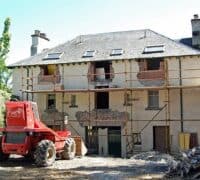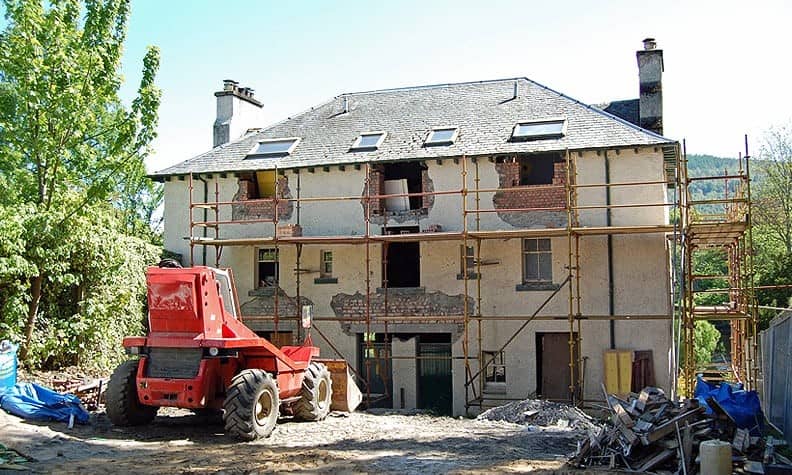
Remodeling a whole house requires a professional design and construction team. As the title implies a complete home remodel is defined as a major home restoration project that substantially guts the majority of the existing home’s finishes down to the studs and foundation.
Remodeling a whole home can also include impact modifications of the structure as well but is typically associated with preserving the integrity of the original structure.
These projects are highly specialized house remodel projects that are usually justified by unique circumstances such as a natural disaster or grand farther zoning ordinances.
This strategy is also used by investors and owners that want to preserve the house structure but want to modernize the infrastructure (MEPs) and update the finishes.
A whole home remodel project is very similar to a typical house remodel project with the exception of the magnitude.
The owners’ motivations are also very similar. The most common justification for a whole house remodeling is that it is usually more cost-effective than tearing the house down and building a new one.
Another driving reason is the home’s location. The owners have zeroed in on the house’s location for distance to work or local schools or maybe the neighborhood and the lot.
Needless to say, there are many justifications that drive owners to completely gut and embark on remodeling a whole house.
In some ways, whole home remodeling is easier than a kitchen remodel project and in other ways it is far more challenging.
We will discuss some of the advantages and disadvantages of undertaking such a project including the justifications for not razing the home in its entirety.
What are the motivations to justify remodeling a whole house?
Whole Home Remodeling Rational
There are a number of rationalizations for undertaking a whole house remodel project instead of using the property as a future home site or selling to someone as a tear down for lot value.
Determining why you want to tackle a monster project is a very important step. You may need to remind yourself at different points of the project’s progress, why you are doing this.
As we have lightly touched on, there are indeed a number of reasons that warrant why you would either be motivated by a financial reason or more likely an emotional rationale to see a project like this through.
Aside from the house itself and the home site, the most common justifications are energy efficiency, historical restoration, staying in the neighborhood, and a major rebuild resulting from the consequences of insurance damage.
1. Neighborhood– Wanting to remain in your neighborhood is a good justification to motivate an owner to strip their house down to the studs. This is especially true in mature higher end home subdivisions that have been built out for years.
These neighborhoods are characterized as the most expensive properties in the city. They are commonly more than 60 years old and are extremely outdated architecturally.
This home condition is very common in full house renovations, where the cost of the land creates a financial barrier to razing the existing house to build a new home.
In addition to deed restriction changes and building code changes, a complete house remodeling can often be grandfathered into permits.
This is viable when there are building restrictions imposed by city officials.
2. Historical Preservation– This is likely the second most popular reason to undertake a whole remodeling project. In many cases, the demo for a vintage property is selective and may not involve gutting the entire house.
Depending on previous renovation projects, an owner may want to preserve the original architecture but update the mechanical, electrical, and plumbing systems.
In other cases, it may involve replacing the exterior doors, windows, and exterior cladding. These historical restoration projects cause the greatest challenges in maintaining the integrity of the original design.
This is due to modern house products being manufactured according to industry size standards. In earlier vintage homes built at the turn of the century, most products were built on-site to the openings provided by a craftsman.
3. Energy Efficiency– A growing justification for a major house renovation of a vintage home is improving energy efficiency. Many older vintage houses did not use insulation in the envelope of the house.
Windows and doors were single pane glass and there was little concern for air infiltration around the perimeter. Updating the latest in-home energy star products can extend the service life indefinitely.
4. Insurance Restoration– Insurance restoration presents the owner with a unique opportunity to remodel while repairing a house.
Upgrading the remodeling project can cost the owner additional funds above the insurance claim benefits. The additional cost of upgrading is easily justified by the subsidized cost of the insurance claim benefits.
Full House Renovation Challenges:
Remodeling a whole house has some unique remodeling challenges that typical house remodel projects do not experience.
Some of these unique problems are the requirements of lead and asbestos abatement, matching old materials, and dealing with previous renovation consequences.
In addition to these unique challenges, vintage homes also have typical house remodel surprises like arranging temporary lodging and unforeseen problems with electricity and plumbing.
1. Unforeseen Problems– It is common to find paint in older homes before 1978 that has led in the paint. There are new federal legal procedures required to properly mitigate the risk of handling and disposing of lead paint.
In addition, asbestos was commonly used in many house products that require abatement when located. This requires a specially certified technician to remove and dispose of products that contain asbestos.
Asbestos was used for fire retarding properties in many home products. Asbestos was typically used in the manufacturing of siding, insulations, ceiling tile, and roofing materials.
The EPA outlawed the use and implemented special requirements for the removal and disposal of it. It also requires a licensed specialist to handle removal.
2. Abatement– It is common to find paint in older homes before 1978 that has led in the paint. There are new federal legal procedures required to properly mitigate the risk of handling and disposing of lead paint.
In addition, asbestos was commonly used in many house products that require abatement when located. This requires a specially certified technician to remove and dispose of products that contain asbestos.
Asbestos was used for fire retarding properties in many home products. Asbestos was typically used in the manufacturing of siding, insulations, ceiling tile, and roofing materials.
The EPA outlawed the use and implemented special requirements for the removal and disposal of it. It also requires a licensed specialist to handle removal.
3. Matching Materials– Building materials and products come and go over time. It only becomes a problem when a home remodeling project requires to match a specific product profile. To overcome a matching problem a contractor must replace all of the material in the immediate area or have special materials custom made to match.
4. Poor Previous Renovations– There is a good likelihood that the older the house the greater the chance of coming across previous remodeling projects.
This alone is not a problem but when the previous work was not executed properly it can present some unexpected issues and cost to modify the new installation of products.
The situation only gets worse when the previous work was not completed to the building code and requires to be completely redone.
5. Temporary Living Quarters– A whole home remodeling project does not allow for a safe way to live in the dwelling during the project. These types of projects require that the owners find temporary living facilities.
This causes additional inconveniences and expenses to the overall project.
Financial Feasibility
Due to the complex nature of a full house renovation, it is advisable to prepare a financial feasibility analysis to compare alternative options, prepare budget contingencies, and prepare a construction schedule control mechanism.
1. Comparing to Alternative Options– Provided that there in fact are other housing alternatives to a full house renovation, financial feasibility should be developed to compare to the cost of alternative housing options.
A feasibility study is like a financial pros & cons list for each option that is being considered. It allows for informed financial decision making and avoiding buyer’s remorse.
2. Budget Contingency– Due to unforeseen surprises that are a normal part of full home remodeling it is important to create budget contingencies. This will reduce the stress caused by insufficient budget funding and provide the owners with the latitude of making important unanticipated changes.
3. Maintaining the Construction Schedule– Developing a full project schedule becomes an excellent method of managing cost and progress throughout the project.
The schedule can keep the project moving forward, while ultimately reducing the cost to carry out the project. It also provides an alert to the owners and construction managers of upcoming material selection requirements.
Home Renovation Contractor
The most important factor of whole home remodeling is selecting a home renovation contractor. The home renovation contractor will help you design, plan and execute the full house renovation.
It is necessary that you determine during the vetting of building contractors which one will be the best fit. You must take into consideration their years of construction experience, their business acumen, their professional reputation, and how well they communicate with you. Having a trusted adviser is essential when preparing and executing a project.
Conclusion
Remodeling a whole house is an outstanding alternative to new house building or moving to a lesser neighborhood. Although it requires a great deal of planning and financial resources to support any unexpected surprises.
It is wise to surround yourself with a professional building contractor that is experienced in such projects and provides you with trusted advice throughout the project. The factors we discussed can make all the difference in experiencing a successful full-house renovation.
Remodeling a whole house is a definite strategy under the proper conditions for owners to extend the service life of a vintage home and capture the architectural and/or value of the property.













